- 1 Canning supplies in Canada
- 2 Canning advice in Canada
- 3 Canadian sources of safe, tested canning recipes
- 4 Botulism cases in Canada from unsafe home canning
- 5 Misc pieces of Canadian home canning history
- 6 Ball jars in Canada
- 7 Home canning at the start of the 1990s in Canada
- 8 Final consolidation in the Canadian home canning supply industry
- 9 Banque de ressources éducatives en français pour conserves maison
- 10 Further reading
Canning supplies in Canada
The largest brand of home canning supplies in Canada is Bernardin, which sells jars, lids, and accessories.
The second largest brand of jars in Canada is “Golden Harvest.” The jars come with lids, but no replacement lids are sold under that brand name.
Both companies are American, and in fact, both are owned by Jarden, which also owns Ball and Kerr in the States.
The largest seller of home preserving supplies in Canada for at least the past several decades appears to be Canadian Tire. “Canadian Tire is the largest domestic purchaser of caps, lids and jars.” [1] Canadian International Trade Tribunal. Inquiry: CAPS, LIDS AND JARS SUITABLE FOR HOME CANNING, WHETHER IMPORTED SEPARATELY OR PACKAGED TOGETFHER, ORIGINATING IN OR EXPORTED FROM THE UNITED STATES OF AMERICA. Inquiry No.: NQ-95-001. October 1995. Page 14.
See our entire page dedicated to the topic of home canning supplies in Canada.
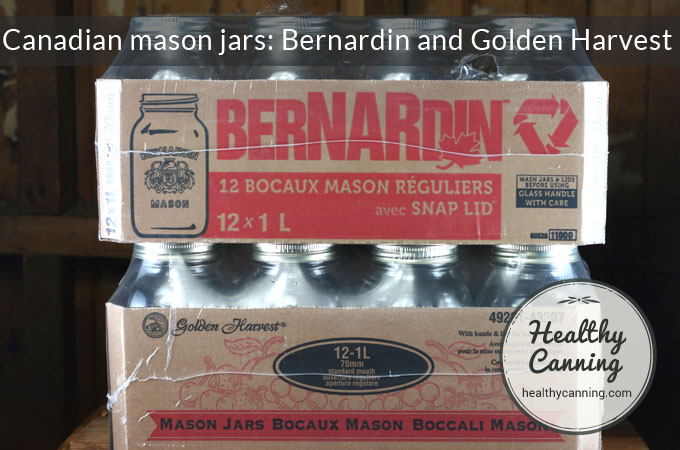
The two brand names of mason jars currently most sold in Canada: Bernardin and Golden Harvest. Specialty Ball jars are periodically available packed in Bernardin boxes.
Canning advice in Canada
During the first half of the 1900s, the national Department of Agriculture was active in issuing advice for home canners, supplemented by advice from the provincial ministries. Since the 1950s, there has been minimal government advice and guidance.
The most energy exerted these days in the field of home food preservation by various Canadian governments seems to be warming about botulism, and repeating the phrase, “The Government of Canada is committed to food safety.” [2] Government of Canada. Home canning safety [Internet]. Ottawa, ON: Government of Canada; [updated 2013 Feb 8; cited 2015 March]. Available from: https://healthycanadians.gc.ca/eating-nutrition/safety-salubrite/food-canning-conserve-aliment-eng.php
When government agencies in Canada do give out more specific canning advice, it can be borderline dangerous at times because it’s too vague, or unhelpful because it’s out-dated. [3] Conf. this blanket advice to sterilize jars and lids: “It is very important to sterilize the jars and seals before use. To sterilize jars, boil them for 10 minutes.” HealthLink BC. Home Canning – How to Avoid Botulism. HealthLinkBC File #22. October 2014. Accessed March 2015 at https://www.healthlinkbc.ca/healthfiles/hfile22.stm
If you want a Canadian source of safe, reliable, comprehensive up-to-date home canning information, use Bernardin as your bible. Canadian Living is another good source of safe, modern home canning practices because their recipes are tested by Bernardin’s labs. Otherwise, be guided by American sources such as the USDA and the National Center for Home Food Preservation. Bernardin and Canadian Living follow their guidelines to the letter.
Agencies in Canada perhaps do best when they just quietly refer home canners on to knowledgeable sources.
The Ontario Agency for Health Protection and Promotion points people to the NCHFP and Ball in the States: “The National Centre for Home Food Preservation and Ball Corporation are examples of sources of validated home canning recipes.” [4] Parto, Naghmeh. Ontario Agency for Health Protection and Promotion (Public Health Ontario). Home canning: literature review. Toronto, ON: Queen’s Printer for Ontario; 2014. ISBN 978-1-4606-4166-8 [PDF] page 9. https://www.publichealthontario.ca/en/eRepository/Home_Canning_2014.pdf
The Wellington-Dufferin-Guelph division of Public Health in Ontario in 2014 points Canadians to the USDA, Ball and So Easy to Preserve as “validated sources of recipes.” [5] #HPDFS(FS)53. https://www.wdgpublichealth.ca/sites/default/files/wdgphfiles/HPDFS%28FS%2953%20Fact%20sheet%20-%20Home%20Canning%20Apr16%202014.pdf . Accessed June 2015.
The Ontario Home Canning FAQs (2015) refers people to the NCFHP and the USDA. [6] https://www.eatrightontario.ca/en/Articles/Cooking-Food-Preparation/Home-Canning-FAQs.aspx. Accessed June 2015.
In doing so, however, Canadian officials might be underlining how little attention they pay to home canning these days, because they completely omit the two science-based, reputable Canadian sources of Bernardin and Canadian Living. A sole Canadian government publication in 2011 includes Bernardin as a good source for Canadians [7] https://www.omafra.gov.on.ca/english/food/inspection/botulism-2011.htm . It’s likely that Canadian officials are informed these days more by the Internet, where US sources dominate.
Discard any canning guides, provincial-government issued or otherwise, that you have from before 2009. The understanding of the procedures required for safety has been dramatically improved.
Disregard any home canning advice from general cookbooks.
Canadian sources of safe, tested canning recipes
Bernardin
Bernardin is the sister company to Ball in the States. Bernadin, like Ball, maintains its own safety test labs and personnel. [8] “There is a Home Economist on staff” https://www.bernardin.ca/pages/faq/33.php#50
Online: Bernardin
In print:
- Bernardin Guide to Home Preserving (make sure you get the most recent edition, which is 2013)
- Ball / Bernardin Complete Book of Home Preserving (produced by Bernardin; most recent edition is 2015. Note: despite the book’s “Complete” title, it contains the same pressure canning recipes as the smaller guide.)
Tidbit for Canadians: Bernardin’s parent company, Jarden, has a contract to supply penny blanks to the Royal Canadian Mint until 2016. [9] Jarden Corporation Annual Report filing with the US Securities and Exchange Commission. 31 December 2013. Commission File Number: 001-13665.
Canadian Living
Canadian Living develops its recipes to Bernardin standards, which meet and exceed USDA standards, and has each recipe lab tested for safety including pH levels, density and heat penetration.
We are confident that that they meet the National Center for Home Food Preservation’s advice of using “tested-recipes based on evidence-based research from reputable sources.”
See our dedicated page discussing Canadian Living’s home canning recipes.
Online: Canadian Living Home Canning Recipes and Guide.
In print: Canadian Living Test Kitchen. The Complete Book of Preserving. Montreal, Canada: Transcontinental Books. 2012. (Note: despite the book’s “Complete” title, it contains no pressure canning recipes.)
Ellie Topp
Many people feel that home canning books authored or co-authored by Canadian Ellie Topp are reputable and reliable. (Topp has a Masters degree in food science from the University of Wisconsin, where she did a major in experimental foods with a minor in microbiology on organisms causing foodborne illness.)
Read more about Ellie Topp.
Emerie Brine
Emerie Brine is the former head instructor at Bernardin. He has now set out on his own. His website is at https://www.emeriebrine.com/
You can read about his background here.
Botulism cases in Canada from unsafe home canning
Canadians have been as guilty of engaging in unsafe canning practices as Americans. Here’s a table of some of the results of that, from 1919 to 2013.
These are cases of botulism from home canned goods across Canada. Note these are only the cases that were diagnosed and documented.
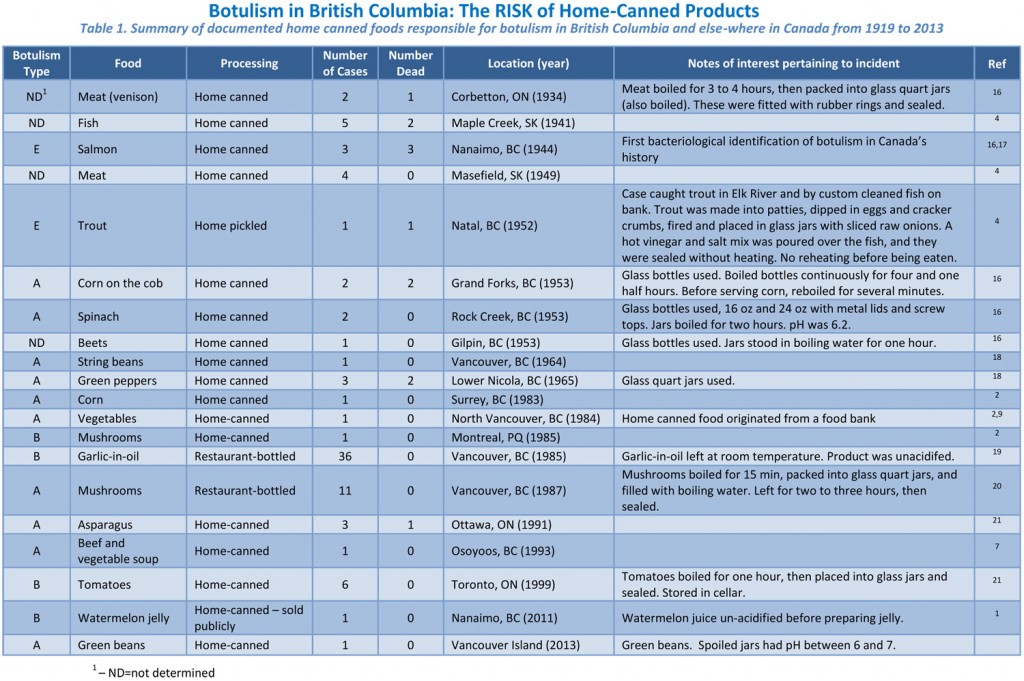
Click to enlarge. (Botulism in British Columbia: The Risk of Home-Canned Products. Food Protection, Environmental Health Services, BC Centre for Disease Control. October 2012. Accessed June 2015. Table 1, Page 4.)
In the 1999 outbreak from tomatoes in Toronto, the cause was “Inadequate pH of the final product.” [10] Loutfy MR, Austin JW, Blanchfield B, Fong IW. An outbreak of foodborne botulism in Ontario. Can J Infect Dis. 2003;14(4):206–9. Available from: https://www.ncbi.nlm.nih.gov/pmc/articles/PMC2094941/
See also: Leclair D, Fung J, Isaac-Renton JL, Proulx J-F, May-Hadford J, Ellis A, et al. Foodborne botulism in Canada, 1985-2005. Emerg Infect Dis. 2013;19(6):961–8.
See also: Foodborne Botulism in British Columbia: A 30 Year history
Misc pieces of Canadian home canning history
Kerr Jars
Kerr was one of the first big brand names (still extant, at least) to start selling mason jars in Canada.
Founded in Oregon in 1903, they were in Canada by 1921 at least, as evidenced by this Hudson’s Bay Company newspaper ad:
They established themselves in the West of Canada and traded there for decades, not venturing east until the 1990s.
With respect to the U.S. suppliers, Kerr had a long history of supplying the subject goods to the B.C. market and an established presence in the Prairies…. In 1992, Kerr began to market caps, lids and jars in the Atlantic provinces and, shortly thereafter, it moved into the larger Quebec and Ontario markets.” [11] Canadian International Trade Tribunal. Inquiry: CAPS, LIDS AND JARS SUITABLE FOR HOME CANNING, WHETHER IMPORTED SEPARATELY OR PACKAGED TOGETHER, ORIGINATING IN OR EXPORTED FROM THE UNITED STATES OF AMERICA. Inquiry No.: NQ-95-001. October 1995. Page 12.
By the 1990s, though, Kerr had a solid Canadian presence, with five distribution centres across Canada:
Kerr, with its head office in Los Angeles, California, was founded in 1903….. Kerr ships the subject goods to a network of warehouses throughout Canada and maintains five Canadian warehouses and one U.S. “hub” distribution centre.” [12] Canadian International Trade Tribunal. Inquiry: CAPS, LIDS AND JARS SUITABLE FOR HOME CANNING, WHETHER IMPORTED SEPARATELY OR PACKAGED TOGETHER, ORIGINATING IN OR EXPORTED FROM THE UNITED STATES OF AMERICA. Inquiry No.: NQ-95-001. October 1995. Page 3. Accessed March 2015 at https://www.citt.gc.ca/en/dumping/inquirie/findings/archive_nq95001_e#I1
At the time, one of their rivals would have been Dominion Glass (see jars section further below).
Canadians and their sealer jars
Canadians used to call their preserving jars / mason jars “sealers”, as evidenced by this 1947 ad. (Small jars for jam and jelly were called “jelly jars.”)
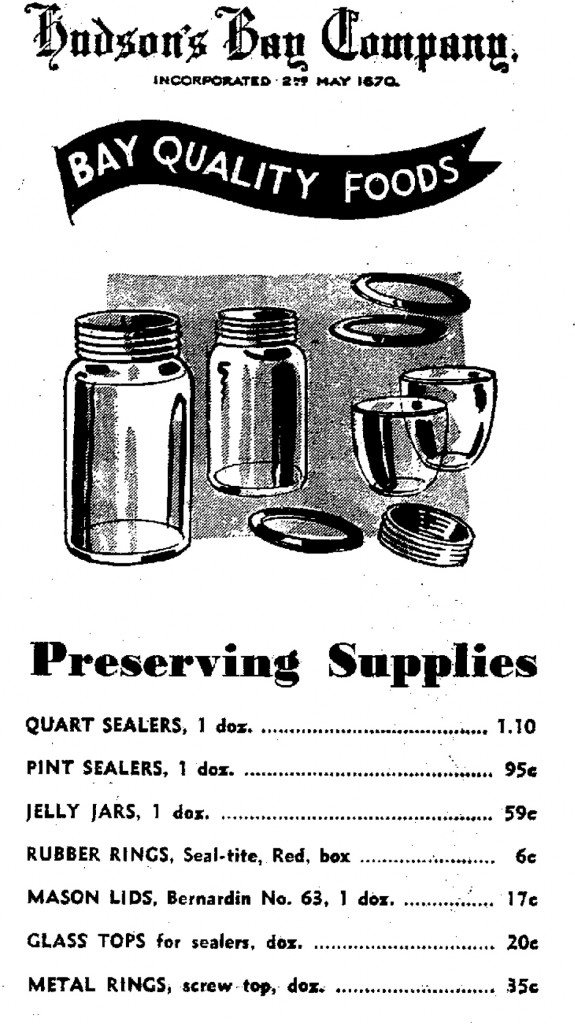
Many Canadians used to call Mason jars “sealers”. (Winnipeg Free Press. 30 July 1947. Page 11. Click to enlarge)
Canadians and Gem jars
Canadians used to have a third mouth-size of jars, called “Gem jars“, as evidenced by this ad.
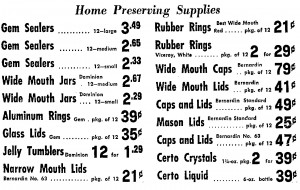
Lethbridge Herald. 29 August 1966. Page 6. Click to enlarge.
This ad above shows the prevalence of Gem jars in the market. It also shows again the old Canadian use of the word “sealer” for preserving jar, and, that at the time, Bernardin was only present in the market selling lids, but not jars.
Bernardin still (as of 2015) sells lids for this third size of mouth; the boxes are labelled “Gem.”
The great Canadian mason jar lid shortage of 1975
In 1975, there was a shortage on mason jar lids and panic buying ensued. The shortage wasn’t actually just in Canada: there was a canning lid shortage at the same time in the States, too.
At the time, home canning was still important enough in Canada for Ottawa to be dragged into the issue, and feel the need to at least be seen as looking into it:
Thousands of homemakers are being advised by the consumer affairs department that lids for canning preserves will be in good supply this year — although the minister admits it’s a mistake and two provinces are conducting inquiries into lid shortages.
The advice is contained in an article in Consumer Contact, the department’s publication with a circulation of more than 150,000. The summer issue is being mailed this week. The article is a mistake, a spokesman for Consumer Affairs Minister Andre Ouellet says. The department now admits there is indeed an acute shortage of the canning lids. A spokesman in the office of Howard Johnston (PC — Okanagan – Kootenay) said last week home canners in the British Columbia fruit-growing region are having ‘a terrible time’ because supplies of lids for widemouth mason jars have been ‘practically nil’ for months. The files of the Consumers’ Association of Canada are bulging with letters complaining about a shortage. But the consumer affairs department believed in June there would be no scarcity this year, Mr. Ouellet’s spokesman said. The article was prepared in June after department officials visited the major canning lid producers.
The department received assurances from the two primary Toronto-based producers, Anchor Cap and Closure Corp. of Canada Ltd. and Bernardin of Canada Ltd., both U.S. – controlled, that their product would not be shipped to United States distributors. ‘Panic psychology’ accounts for the shortage that has developed since June, the spokesman said. “Consumers have been buying and hoarding the lids, anticipating a shortage.”
He said most of the problem appears to be located in parts of B.C. and in southern Alberta. There have been ‘sporadic problems’ with supply in Ontario, notably in the Windsor area, the spokesman said. The Ontario government announced Aug. 6 that it was initiating a study into the shortage of sealing lids. And BC Consumer Services Phyllis Young announced Aug. 14 an investigation into shortages of home canning supplies was being started.
The federal spokesman said Anchor had expanded its plant capacity for making lids and that Bernardin has added extra shifts in an effort to meet very strong consumer demand, which he said is the main reason for the current shortage.
He also said officials were ‘submitting policy options to Mr Ouellet for action to ensure that this will not happen again.’ However, he could not say what action the department might take. In the United States.. federal consumer protection officials acknowledged the lid shortage months ago….”
From: Canadian Press. Home canners still facing acute lid shortage. Lethbridge, Alberta: The Lethbridge Herald. 20 August 1975. Page 33
Canadians used to have two main sources of metal mason jar lids
There used to be two main companies supplying Canadians with metal mason jar lids: Anchor Cap and Closure (aka Anchor Hocking), and Bernardin. Both were based in Toronto. Anchor called their lids “Steriseals”; Bernardin called their lids “SNAP LIDs®”.
Kerr also sold lids to some extent in some regions.
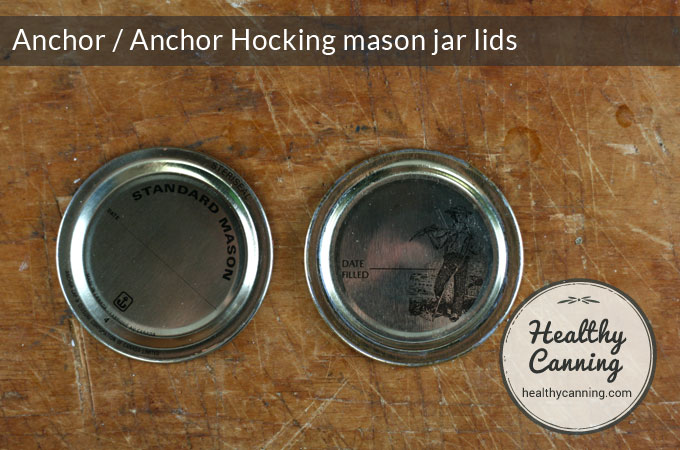
Anchor lid (L); Anchor Hocking lid (R). Both are same US company.
Ball jars in Canada
A newspaper ad from Winnipeg shows Ball branded jars being sold there in 1978.
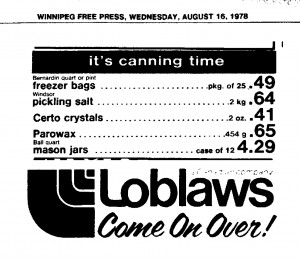
Winnipeg Free Press, Wednesday, 16 August 1978. Click to enlarge.
It appears that Ball entered the Canadian market in a bigger way in 1991: “Alltrista [Ed: a later name for the Ball jar division] had been the price undercutter when it entered the Canadian market in 1991… Alltrista’s marketing efforts were centred on the high-volume accounts in Ontario and Quebec.” [Note the tribunal has the timing of the name slightly wrong: the Ball mason jar division wasn’t named Alltrista until 1993.] [13] Canadian International Trade Tribunal. Inquiry: CAPS, LIDS AND JARS SUITABLE FOR HOME CANNING, WHETHER IMPORTED SEPARATELY OR PACKAGED TOGETHER, ORIGINATING IN OR EXPORTED FROM THE UNITED STATES OF AMERICA. Inquiry No.: NQ-95-001. October 1995. Page 12.
Consumer’s Glass and Domglas Mason Jars
Here’s a Canadian Tire ad from 1982.
The jars pictured appear to be similar to this one shown below.
There was also a brand of mason jars called “Dominion.” The company had started life in 1895 as Foster Brothers Glass Works [14] https://www.corellecorner.com/chrome-top-guide/81-dominion-glass.html Accessed June 2015, then was renamed to Diamond Glass in 1890, and then became “Dominion” in 1913. [15] https://www.thecanadianencyclopedia.ca/en/article/glass/ Accessed June 2015.
In 1976, Dominion Glass renamed itself to “Domglas.” [16] https://www.corellecorner.com/chrome-top-guide/81-dominion-glass.html Accessed June 2015
Domglas, along with Consumers Glass, were two of the last surviving brands of mason jars made in Canada.
Consumers Glass bought out Domglas in 1989. [17] “Consumers Glass merged with Domglas Inc. in 1989.” Canadian International Trade Tribunal. Inquiry: CAPS, LIDS AND JARS SUITABLE FOR HOME CANNING, WHETHER IMPORTED SEPARATELY OR PACKAGED TOGETHER, ORIGINATING IN OR EXPORTED FROM THE UNITED STATES OF AMERICA. Inquiry No.: NQ-95-001. October 1995. Page 5. ” A long-time rival of Dominion Glass, Consumers Packaging, the former Consumers Glass Company, acquired Domglas Inc. in 1989.” [18] https://www.corellecorner.com/chrome-top-guide/81-dominion-glass.html Accessed June 2015
At this point, there were two companies left in Canada making home canning supplies in the country: Consumers Glass, and Bernardin. Both, though, were actually American owned. [19] “Consumers Glass, founded in 1917, is controlled by G&G Investments, Inc. of Pittsburgh, Pennsylvania.” [20] Canadian International Trade Tribunal. Inquiry: CAPS, LIDS AND JARS SUITABLE FOR HOME CANNING, WHETHER IMPORTED SEPARATELY OR PACKAGED TOGETHER, ORIGINATING IN OR EXPORTED FROM THE UNITED STATES OF AMERICA. Inquiry No.: NQ-95-001. October 1995. Page 3.
Only Consumers Glass made preserving jars in Canada; Bernardin did not:
[Consumers Glass] is the only manufacturer of glass containers, including mason jars, in Canada. Consumers Glass operates seven plants across Canada and produces a full line of glass containers, including for beer, juice, food, liquor and wine. Mason jars are manufactured, using dedicated moulds, at plants in Toronto and Hamilton, Ontario, Pointe Saint-Charles, Quebec, and Lavington, British Columbia.” [21] Canadian International Trade Tribunal. Inquiry: CAPS, LIDS AND JARS SUITABLE FOR HOME CANNING, WHETHER IMPORTED SEPARATELY OR PACKAGED TOGETHER, ORIGINATING IN OR EXPORTED FROM THE UNITED STATES OF AMERICA. Inquiry No.: NQ-95-001. October 1995. Page 3.
The two companies actually cooperated:
Until 1994, Bernardin produced and sold caps and lids to the retail trade. It also sold …. packs of caps and lids to Consumers for sale with its Mason jars.” [22] “Canadian International Trade Tribunal. CAPS, LIDS AND JARS SUITABLE FOR HOME CANNING, WHETHER IMPORTED SEPARATELY OR PACKAGED TOGETHER, ORIGINATING IN OR EXPORTED FROM THE UNITED STATES OF AMERICA. Ref No.: RE-94-002. 28 April 1995. Page 2.
More info on Domglas / Dominion / Consumers
Bottle Mould Numbers from the Dominion Glass Company and its Predecessors
Try https://www.antique-bottles.net (Very helpful people)
Home canning at the start of the 1990s in Canada
In the 1990s, the powers that be felt that the Canadian market for home canning supplies was a market in decline: “A number of factors indicate that the domestic market for home canning products is mature, with only moderate growth anticipated, at best. Among the factors which indicate little growth in the future for these products are changing lifestyles, such as an increase in the number of working women and smaller family size. As well, the increasing year-round availability of fresh fruits and vegetables and alternative preservation methods will also serve to restrain demand for home canning products.” [23] Canadian International Trade Tribunal. Inquiry: CAPS, LIDS AND JARS SUITABLE FOR HOME CANNING, WHETHER IMPORTED SEPARATELY OR PACKAGED TOGETHER, ORIGINATING IN OR EXPORTED FROM THE UNITED STATES OF AMERICA. Inquiry No.: NQ-95-001. October 1995. Page 12.
By the mid 1990s, Consumers Glass and Bernardin were the only two home canning supply companies still in business that actually made their wares in Canada: “The evidence shows that [Consumers Glass and Bernardin] production constitutes 100 percent of the total domestic production of the like goods and, therefore, the Tribunal finds that Consumers Glass and Bernardin constitute the domestic industry in this inquiry.” [24] Canadian International Trade Tribunal. Inquiry: CAPS, LIDS AND JARS SUITABLE FOR HOME CANNING, WHETHER IMPORTED SEPARATELY OR PACKAGED TOGETHER, ORIGINATING IN OR EXPORTED FROM THE UNITED STATES OF AMERICA. Inquiry No.: NQ-95-001. October 1995. Page 11.
Even though the home canning supplies market was declining, competition for it was tense.
In 1994, Consumers Glass and Bernardin complained that Ball ( aka Alltrista at the time) and Kerr had been, between 1991 and 1994, illegally flooding the Canadian market with “caps, lids and jars suitable for home canning” by use of price dumping.” A trade tribunal ended up agreeing with them: “the Tribunal finds that the dumping in Canada of caps, lids and jars suitable for home canning, whether imported separately or packaged together, originating in or exported from the United States of America, has caused material injury to the domestic industry.” [25] Canadian International Trade Tribunal. Inquiry: CAPS, LIDS AND JARS SUITABLE FOR HOME CANNING, WHETHER IMPORTED SEPARATELY OR PACKAGED TOGETHER, ORIGINATING IN OR EXPORTED FROM THE UNITED STATES OF AMERICA. Inquiry No.: NQ-95-001. October 1995. Page 21. The Tribunal felt that the price dumping weakened both of the domestic producers: “Both companies incurred large decreases in sales revenues, which resulted in declining profitability and a significant decrease in production and employment levels. [26] Canadian International Trade Tribunal. Inquiry: CAPS, LIDS AND JARS SUITABLE FOR HOME CANNING, WHETHER IMPORTED SEPARATELY OR PACKAGED TOGETHER, ORIGINATING IN OR EXPORTED FROM THE UNITED STATES OF AMERICA. Inquiry No.: NQ-95-001. October 1995. Page 16.
The pricing data indicate that, in Western Canada, Kerr maintained its position as the predominant supplier. Price pressures from the subject goods appeared to be less severe in the western market, which can be partially attributed to the minor presence of [Ball], Kerr’s long history in that market and the tendency of purchasers to buy from more than one supplier. However, in the Atlantic provinces, price competition became intense when Kerr entered that market in 1992 ([Ball] did not compete in the Atlantic provinces). The evidence reveals that Kerr undercut Bernardin’s prices for caps and lids, and the extent of the price undercutting increased over time. Although Kerr’s jar prices were initially higher than those of Consumers Glass, in 1993, Kerr’s prices were considerably lower, which resulted in Consumers Glass’ decision to essentially withdraw from the Atlantic provinces. In 1994, Kerr increased its prices for mason jars in these provinces. In 1992, Kerr entered the Quebec and Ontario markets. As previously noted, [Ball] had targeted a number of large accounts in these two provinces and, with the entry of Kerr, price competition became intense. As a result, in 1993, prices declined, and the two domestic producers [Ed: Consumers Glass and Bernardin] incurred a significant loss of sales at several accounts and suffered price suppression at a number of other accounts.” [27] Canadian International Trade Tribunal. Inquiry: CAPS, LIDS AND JARS SUITABLE FOR HOME CANNING, WHETHER IMPORTED SEPARATELY OR PACKAGED TOGETHER, ORIGINATING IN OR EXPORTED FROM THE UNITED STATES OF AMERICA. Inquiry No.: NQ-95-001. October 1995. Page 13.
Final consolidation in the Canadian home canning supply industry
By the mid-1990s, there were two American-owned companies, Consumers Glass and Bernardin, making goods in Canada, competing against two other American-owned companies, Ball and Kerr, who made their goods across the border in the States.
At the end of 1994, Ball (under the corporate name of Alltrista) decided to end the trade complaints being lodged by Bernardin by simply buying Bernardin. “Like Ball Corporation, Bernardin had a rich history in the canning products market; since 1881, the company had been producing metal lids for commercial and home canning containers. [28] https://www.fundinguniverse.com/company-histories/alltrista-corporation-history/
After the purchase of Bernardin, Ball (aka Alltrista) then stopped selling its Ball-branded merchandise in Canada, ceasing the competition with Bernardin: “Alltrista, subsequent to its acquisition of Bernardin in November 1994, withdrew from the Canadian market.” [29] Canadian International Trade Tribunal. Inquiry: CAPS, LIDS AND JARS SUITABLE FOR HOME CANNING, WHETHER IMPORTED SEPARATELY OR PACKAGED TOGETHER, ORIGINATING IN OR EXPORTED FROM THE UNITED STATES OF AMERICA. Inquiry No.: NQ-95-001. October 1995. Page 3.
Consumers Glass was still around in 1995, at which point it began making jars for Bernardin: “In 1995, Consumers will manufacture Mason jars under an exclusive contract with Bernardin. Bernardin will be responsible for the sale and distribution of the product.” [30] “Canadian International Trade Tribunal. CAPS, LIDS AND JARS SUITABLE FOR HOME CANNING, WHETHER IMPORTED SEPARATELY OR PACKAGED TOGETHER, ORIGINATING IN OR EXPORTED FROM THE UNITED STATES OF AMERICA. Ref No.: RE-94-002. 28 April 1995. Page 2.
In 1996, the Ball (Alltrista) company acquired the Kerr company, closing production in Jackson, Tennessee and consolidating Kerr and Ball production in Muncie, Indiana.
In the fall of 2001, Bernardin shut down all Canadian manufacturing completely and moved the manufacture of their products to the Ball plant in Muncie, Indiana. [31] “Alltrista shut Bernardin’s lid plant in Toronto in the fall of 2001 and consolidated production at its Muncie, Ind., plant.” Chipello, Christopher J. Canadians Blow Their Tops As Canning Lids Get the Can. Wall Street Journal. 21 January 2003. Accessed March 2015 at https://www.wsj.com/articles/SB1043099833887518344 .
In 2002, the umbrella company that owned Ball, Bernardin and Kerr (as well as Golden Harvest) renamed itself from Alltrista to Jarden.
Ball, Bernardin and Kerr, the former rivals, are now sister companies sharing resources, knowledge and product. The main difference is that jars produced for the Bernardin brand are metric sizes (e.g. ½ litre instead of 1 US pint), and so are anywhere from 1 to 3 tablespoons bigger than the US market jars.
Banque de ressources éducatives en français pour conserves maison
Ressources canadiennes pour les conserves maison
Further reading
Parto, Naghmeh. Home canning: literature review. Ontario Agency for Health Protection and Promotion (Public Health Ontario). Toronto, ON: Queen’s Printer for Ontario; 2014. ISBN 978-1-4606-4166-8 [PDF].
BC Centre for Disease Control. Botulism in British Columbia: The RISK of Home-Canned Products. January 2015.
References

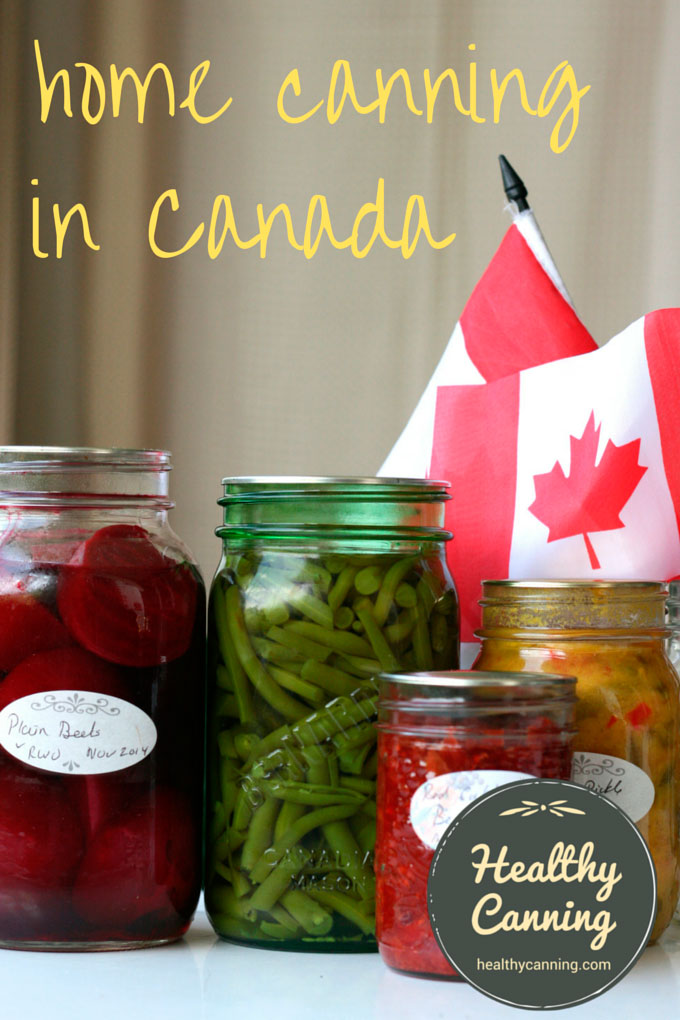


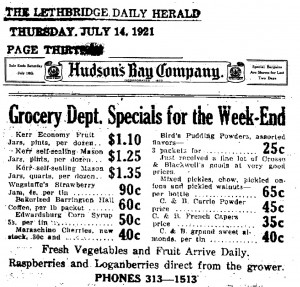
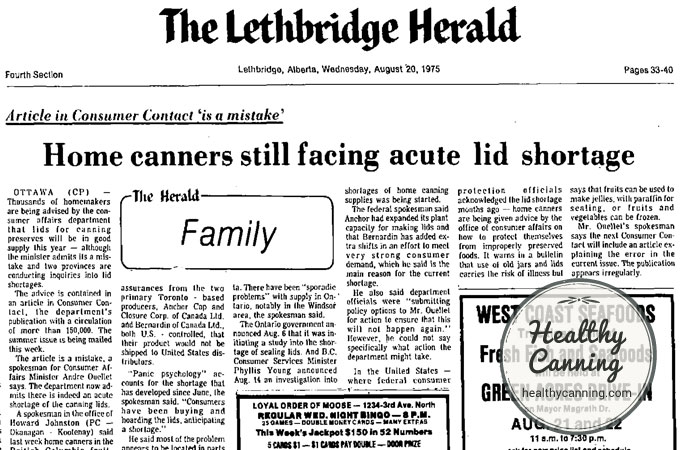
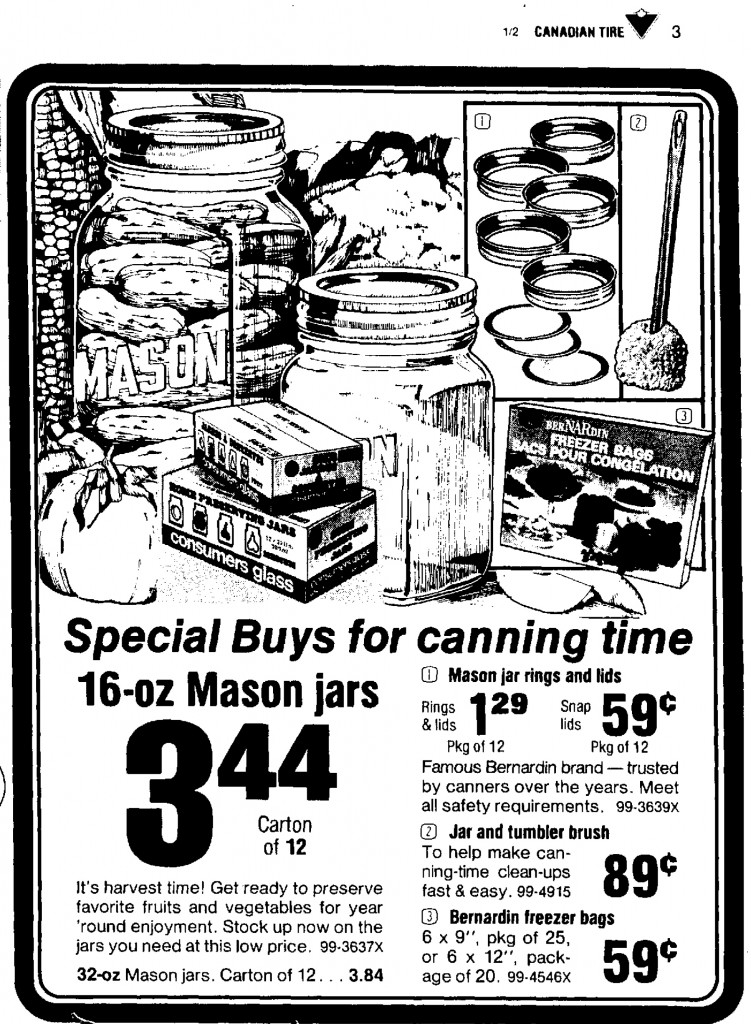
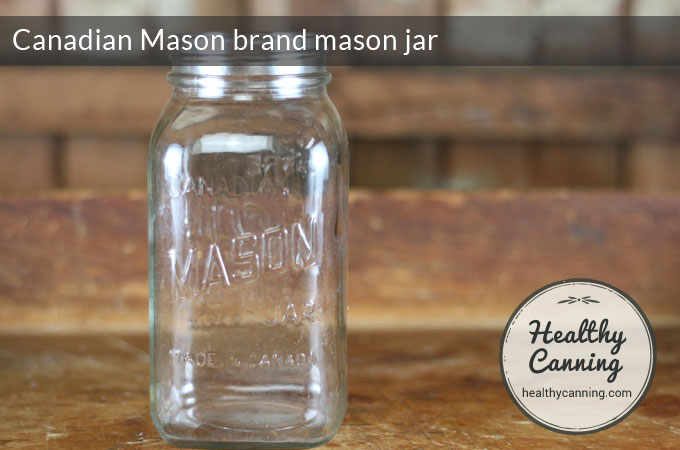
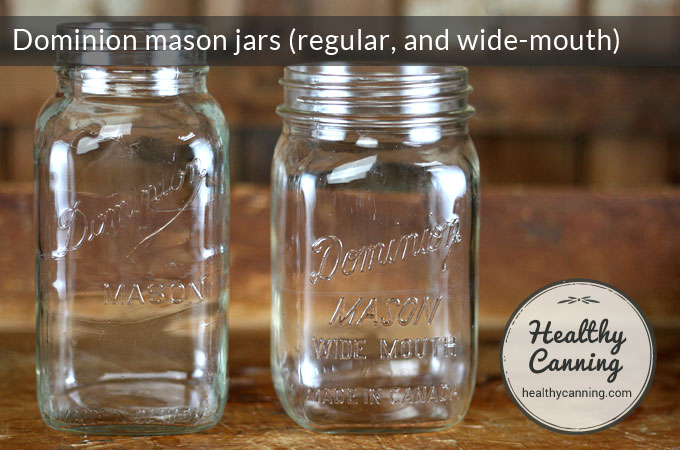
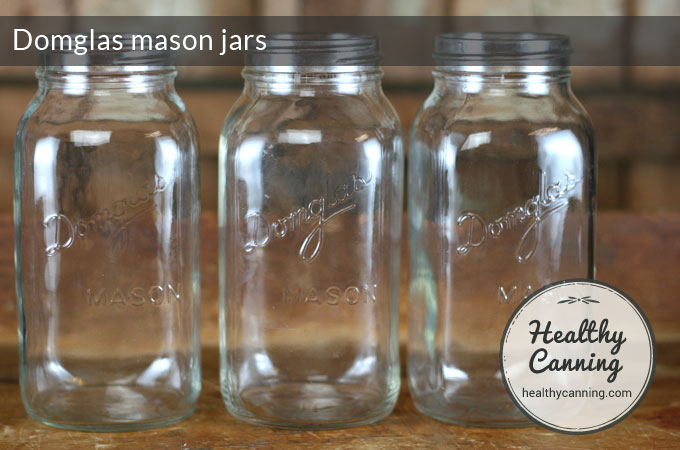
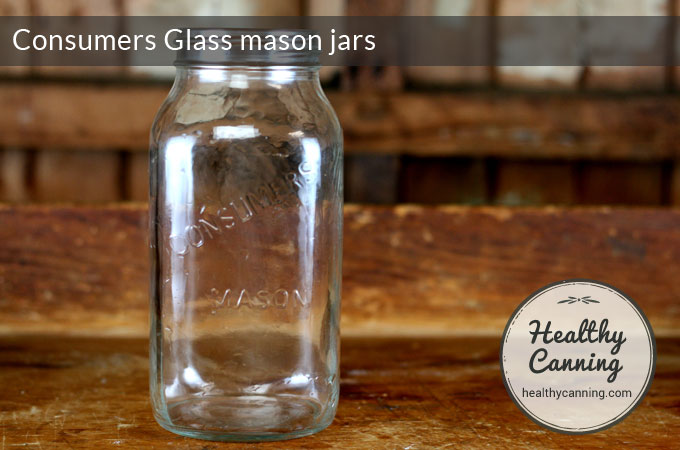
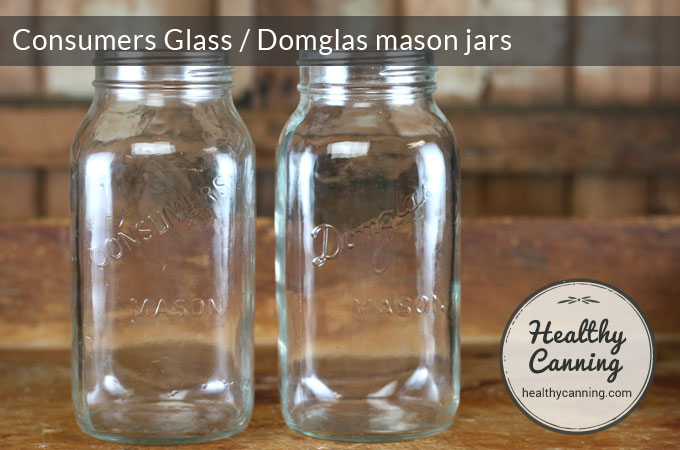
DonnaB
Weird message posted at top of this page in the large pink box stating:
WARNING: unbalanced footnote start tag short code found.
If this warning is irrelevant, please disable the syntax validation feature in the
dashboard under General settings > Footnote start and end short codes >
Check for balanced shortcodes.
Unbalanced start tag short code found before:
““Consumers Glass, founded in 1917, is controlled by G&G Investments, Inc.
of Pittsburgh, Pennsylvania.” ”
Please check into this and correct. Looks like a computer programming issue.
Healthy Canning
Thanks for the heads up, Donna! It happens when a piece of coding for closing a footnote has been missed. Fixed!
Jennifer
Great article. So much history! Happy canning everyone!!!!
G
Is it safe to pressure can stews in the 1.9 liter Bernardin jars? What can these large jars be used for safely? Thank you. 😊
Healthy Canning
Please see here for a discussion of uses for Bernardin’s 1.9 litre (2 US quart) jars: https://www.healthycanning.com/bernardin-jars/#Bernardin_2_US_quart_jar_wide_mouth
William Rae
It’s a shame that one company has control of the home canning market. They have complete control over quality or lack thereof. . This is the second canning season that there is a shortage of certain items such as wide mouth snap lids. But!!! complete sets are available? DUH! At one time this would have been a Monopoly . I will look into any alternate ways of keeping my food for later use.
Healthy Canning
Freezing and dehydrating are great ways of storing food.
naomi
What a well written, throughly researched article. I have inherited a couple hundred Canadian preserving jars dating back to 1900. This is by far the best article I have found on the subject. (Much better than the Unitt;s books) . THANK YOU!
Angie Desfosses
I have a commercial business where I can 10 different flavors of pickled eggs. Can you show me guidelines for canning this food item, all of my prices have met the Canadian food inspection Agency’s standards in canada, however, it is hard to find a hard copy of guidelines for canning pickled eggs.
Healthy Canning
Hi Angie, you will need to contact a process developer to develop a safe commercial canning process specifically for you.
Stephanie
I inherited a lot of large various types of glass jars – some are Mason, some are Consumer Glass, some are Ball. All the wide mouth jars do not use the same wide lids ie, 86 mm sise – they are bigger. Can’t seem to find this size on sale anywhere. Does anyone know where I could get them from ? thanks
Peter C
Nice history. Sorry to hear that the old Mason brand jars aren’t being made anymore — I couldn’t seem to find them. Those old Mason brand jars are good for food storage, as they have flatter sides than recent Bernadin jars I have seen, and come in a slightly taller, thinner version of the 1L size. Easier to grasp.
Miss Conserves
What an amazingly informative article! Thank you so much for your hard reseach work full of links and quotes and stuff. This is university quality work and pretty rare on the internets. Keep up the awesome work!